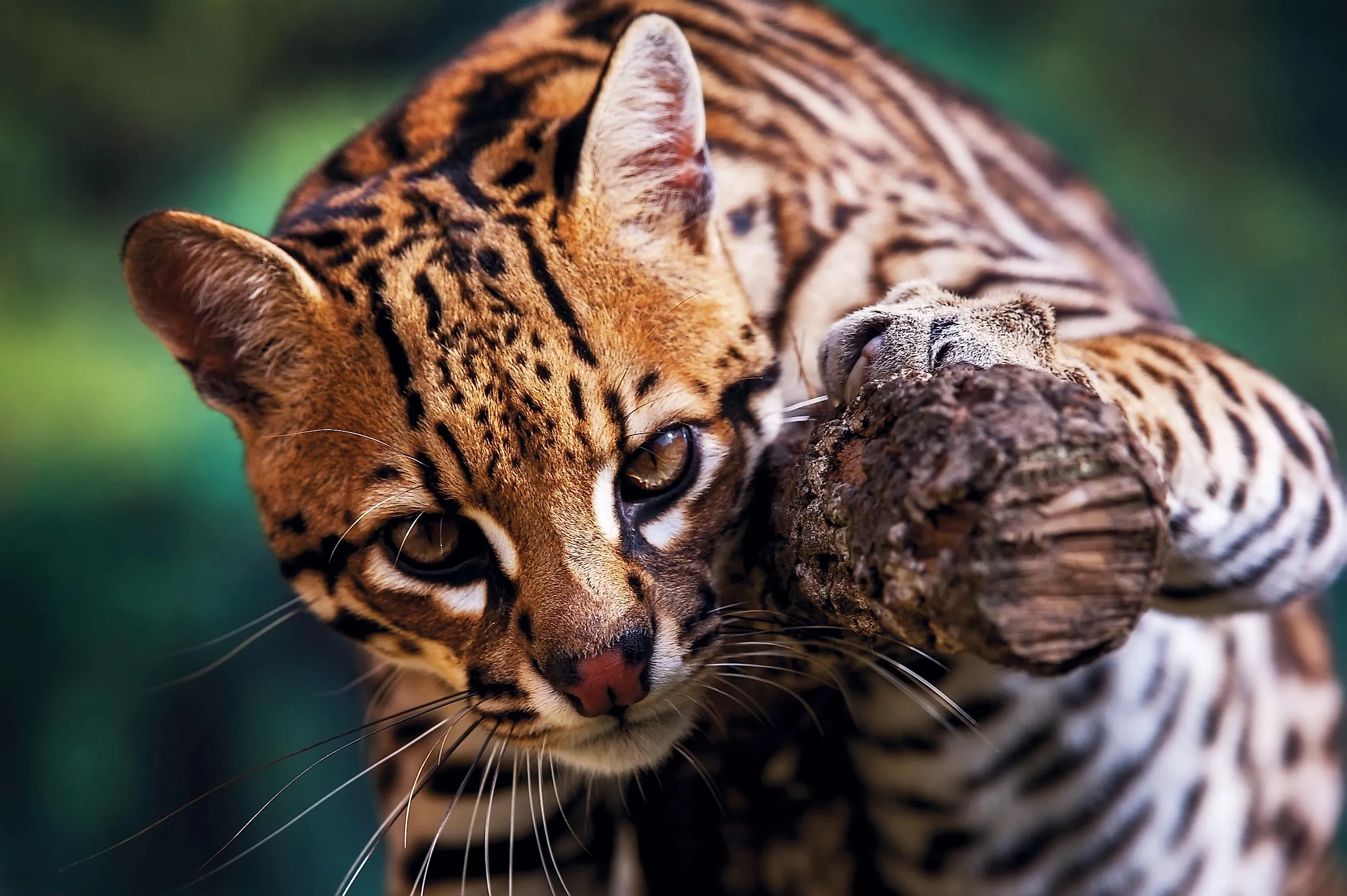
The 13 Coolest Animals In Texas
Texas is the second-largest state, behind Alaska, and the second-most populous after California. The Lone Star State has its share of animals, too. This South-Central boundary covers ten climatic regions and eleven ecological regions, resulting in some uniquely adapted reptiles, birds, mammals, and more. While many populations are thriving along the Gulf Coast, within the Chihuahuan Desert, and everywhere in between, there are 74 threatened and 148 endangered species (such as the whooping crane, ocelot, and black-footed ferret) that rely on these environments as some of the last bastions for their existence. Big or small, endangered or thriving, these are thirteen of the coolest animals found in Texas.
Whooping Crane
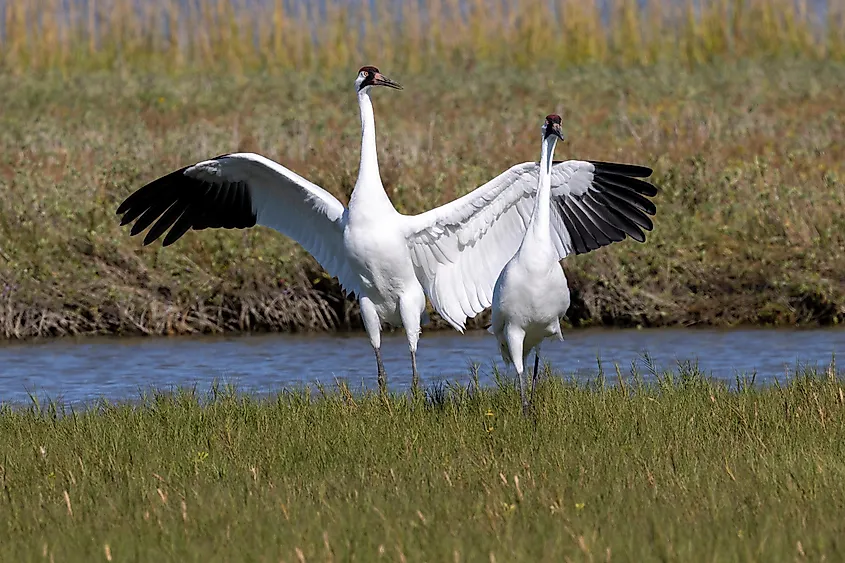
The whooping crane (Grus americana) is the tallest bird in North America. It stands at nearly 5 feet and bears a wingspan of 7.5 feet. Not only does its size make it stand out on the salt flats and marshes of Texas' coastal plains, but so does its bedsheet-white body, black-tipped wings (visible only while in flight), black legs and bills, and rust-colored head patches. Endangered both on a federal and state level due to habitat loss and unregulated hunting in the past, the whooping crane is holding on in small numbers in Florida's Kissimmee Prairie, in Wisconsin (where it is only bred in captivity), and at the 22,500-acre Aransas National Wildlife Refuge in Southeast Texas. The latter group, which reached a low of 18 individuals in the 1930s (since rebounded into the low hundreds), is the only migratory population. Each spring, they fly to their breeding grounds at Wood Buffalo National Park in Northern Canada before returning in the fall (a yearly distance totaling roughly 2,400 miles).
Texas Horned Lizard
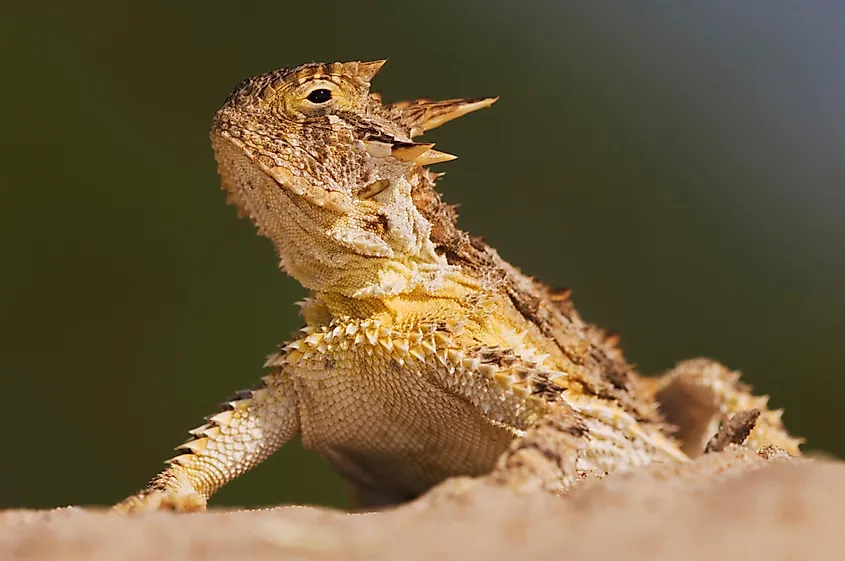
The cool-looking Texas horned lizard (Phrynosoma cornutum) has earned the honors of state reptile (despite its dwindling numbers). This ostensibly fierce little fellow is covered in small spikes with two prominent head spines or horns. It has a flat body, which creates a common confusion that it is actually an amphibian (often referred to as a "horned toad" or "horny toad"), but when threatened, it can inflate to appear larger and even shoot blood from its eyelids. That said, its first line of defense is camouflage.
Despite these strategies, the Texas horned lizard is unfortunately listed as threatened in its namesake state. Increased urbanization leading to habitat loss, planting of nonnative grass species to feed livestock, use of pesticides, and introduction of invasive fire ants replacing the red harvester ants that these lizards feed on are some of the many threats facing these reptilians. The remaining populations can be found in open areas with little plant cover, and because they burrow to hibernate, nest, and keep warm generally, they like sand and loose soil.
Texas Tortoise
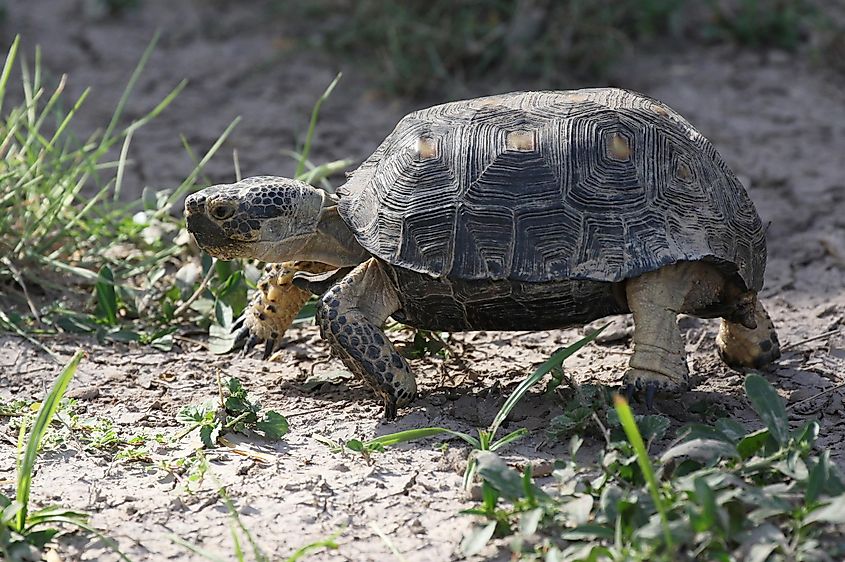
Another interesting reptile named after the state is the Texas tortoise (Gopherus berlandieri). While it does exist South of the border, in the Mexican states of Coahuila, Nuevo Leon, and Tamaulipas, this species (identifiable by the yellow-orange, slightly horned plates on its shell) is endemic to North America. These lazy vegetarians love to feed on the fruit of the prickly pear and other succulents. They are not only patient on a day-to-day basis, but their life cycle takes its time too. Texas tortoises reach sexual maturity at about 15 years and can live for as long as 60 years. However, such a low reproductive rate, combined with their exploitation as pets, has resulted in a marginalized population in South-Central Texas (i.e., its only territory in the United States). It is listed as threatened and is now banned from possession, transportation, sale, and anything else to do with the pet industry.
Texas Longhorn
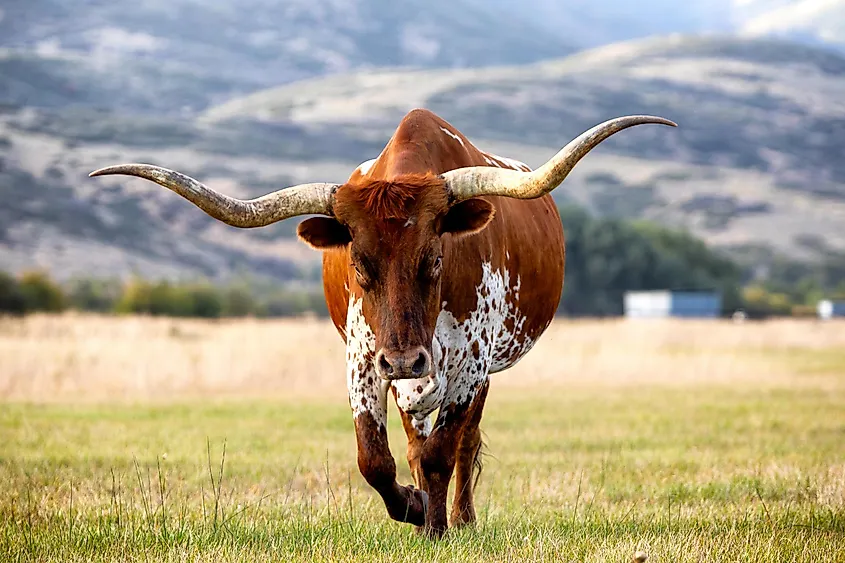
The state mammal of Texas is a crown shared by the nine-banded armadillo (our next topic of discussion) and the Texas longhorn. Though an icon today in the Southern United States, this cattle species has a worldly lineage. Descended from Middle Eastern and Indian relatives (who met in North Africa), the hybrid bulls and cows eventually crossed into Southwestern Europe. When Christopher Columbus and other Spanish colonists began their ventures to the New World, they brought along a variety of cattle lineages, which were purchased from the Canary Islands en route. By the early 16th century, the Spaniards, and by extension, the longhorns, shifted into parts of South America, Mexico, and modern-day Texas. They were able to fend off local predators with their sizable steers, and their leanness helped during times of drought. Then, in the 19th century, the invasive cattle bred with the more robust Northern European varieties that the Anglo-American settlers brought over, thereby resulting in what was eventually named the Texas longhorn. After a scare of extinction, this budding breed of bovine made a big comeback in the 20th century when it became one of the mascots of Texas.
Nine-Banded Armadillo
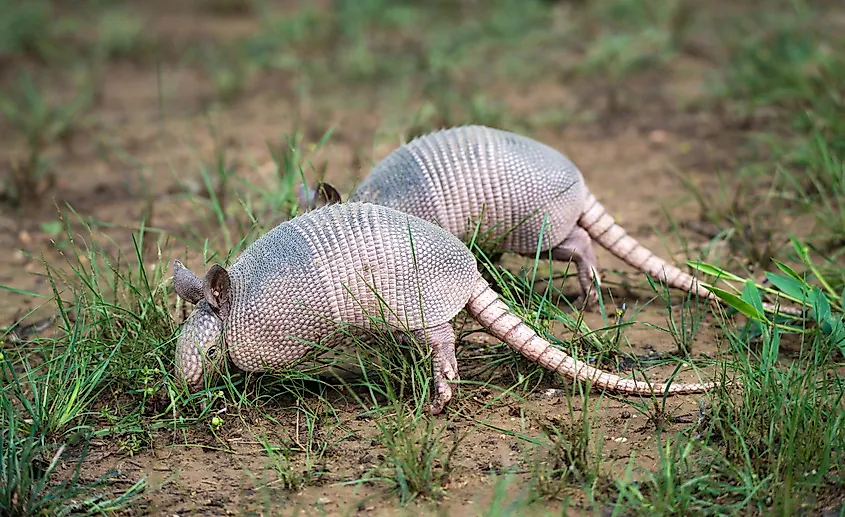
The other state mammal of Texas (authorities make a large and small distinction) is the nine-banded armadillo (Dasypus novemcinctus). This quintessential Lone Star creature was originally native to South America but has since shifted into Texas (everywhere except the Western portion of Trans-Pecos), Louisiana, Oklahoma, and Kansas. Specifically, it seeks out places where the soil is soft enough to dig burrows and dig for food (they like grubs and other insects and sometimes mix in some berries and even bird eggs for good measure). The nine-banded armadillo is about the size of an average cat – that is if it wore a natural plate of armor. This bony, scaled shell protects them from predators but, sadly, is no match for speeding cars. As such, armadillos are often sighted in the form of roadkill.
Northern Mockingbird
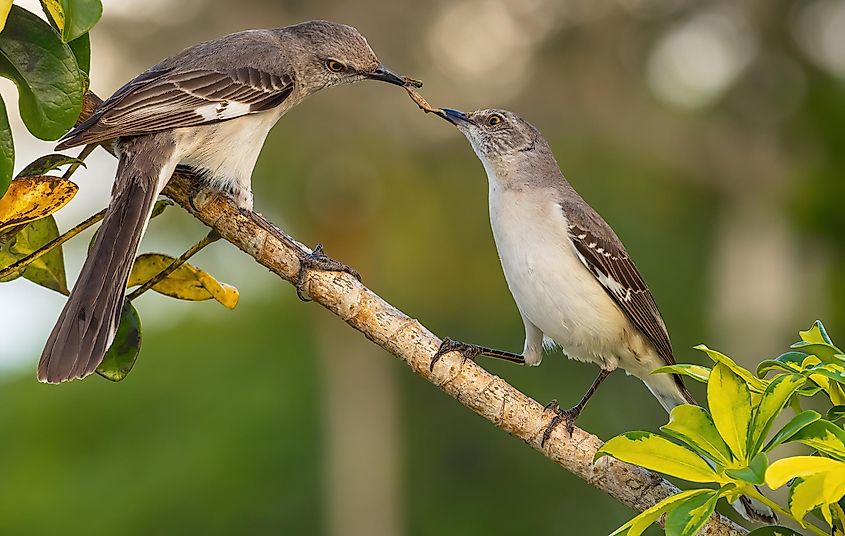
Texas' official bird is music to everyone's ears (during the daytime, anyway): the northern mockingbird (Mimus polyglottos). This medium-sized songbird is the most sighted (or heard) in the state. You'll know you've got one when you see the dull gray feathers over a pale belly. Its persistent vocalizations will also be a dead giveaway. This sound can be enjoyable during waking hours, as males attempt to attract a lady bird, or defend their territory (note: almost every habitat in Texas is a viable domain for this master generalist), but frustrating after dark, when those unmated males feel the need to vent their woes. According to researchers, females are drawn to males who can produce the widest variety of sounds (sorry to all you one-hit-wonders out there).
Monarch Butterfly
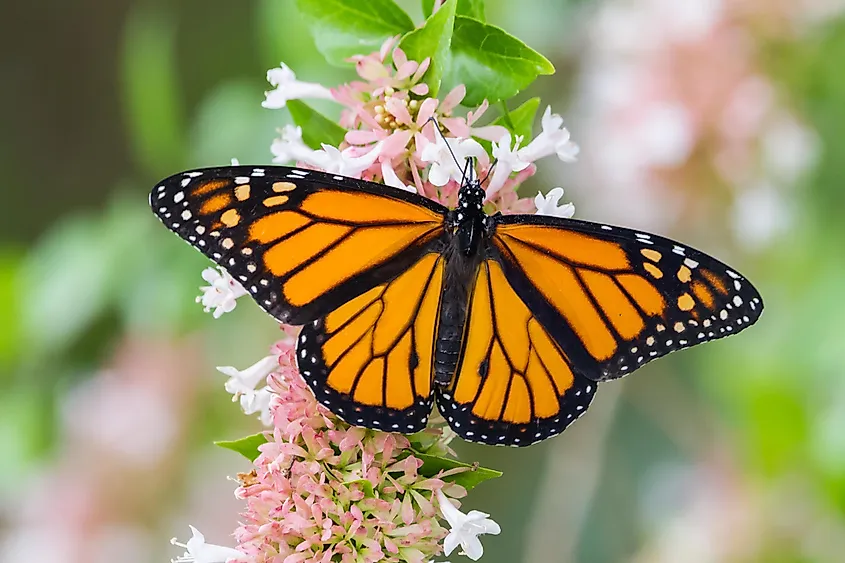
Believe it or not, Texas even has a state insect: the monarch butterfly (Danaus plexippus). With its large orange wings bordered and lined in black and punctuated with white and orange spots, this species is easily one of the world's most recognizable butterflies. Each winter, monarchs lay their eggs amongst the milkweeds of Texas, as well as California and Mexico, before migrating to Southern Canada each spring (every province but Newfoundland & Labrador). That is an amazing migration for any being, let alone for an insect. But I'm afraid the story has to end with a dark twist. Even though monarchs are still commonly spotted, the primary food source during their caterpillar phase (milkweed) is rapidly disappearing, which has wreaked havoc on their population since the 1980s.
Swift Fox
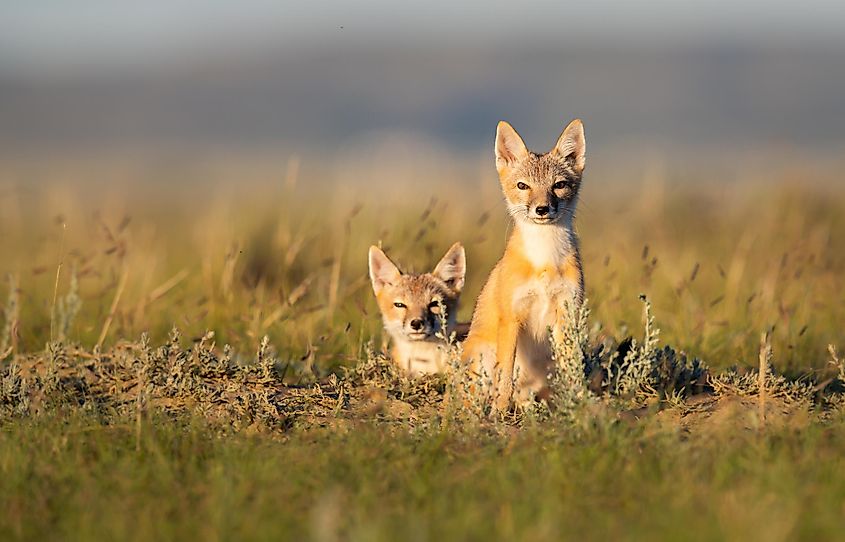
The swift fox (Vulpes velox), aka the kit fox, is a nifty little creature. It is the smallest of all American foxes, with pale yellow fur, a fluffy tail with a black spot both at the base and the tip, brownish ears, and a long snout. They like to stay close to their dens and use bursts of speed to retreat to safety or to hunt everything from small mammals to birds, lizards, amphibians, fish, and insects. Throughout the Western third of Texas, the swift fox can be found in open desert grasslands, hunting on mesas and sparsely vegetated hills. It has also reportedly adapted to ranchlands. Overall, the swift fox is doing well, but in certain areas, it suffers greatly at the hands of trappers and in regions where poison is used to reduce wild predators.
Western Diamondback Rattlesnake
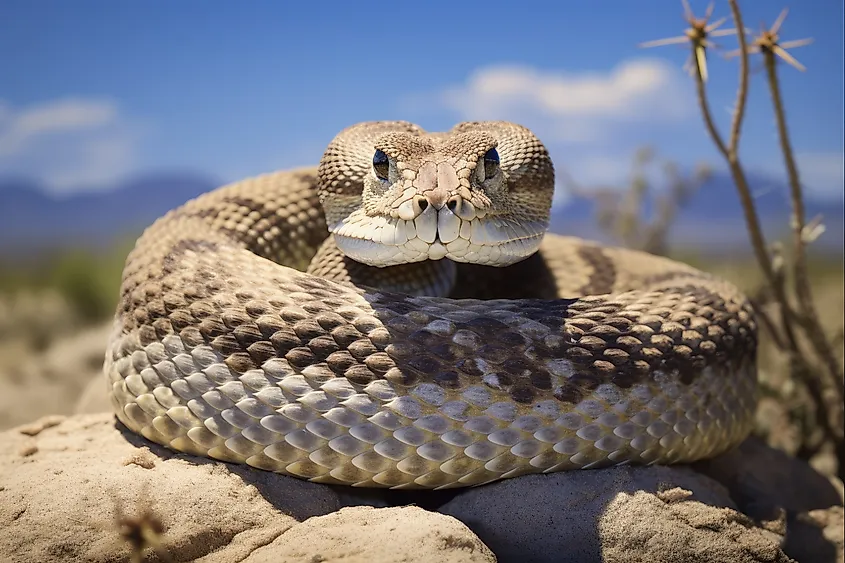
Another icon of the desertscape (both its appearance and its audio) is the western diamondback rattlesnake (Crotalus atrox). Found across the Southwestern United States and Northern and Central Mexico, this venomous snake can be identified not only by its rattle (a warning to passersby to steer clear) but also by its dark diamond or hexagonal blotches that run all along its otherwise brown-gray back. It also sports a pair of hollow, retractable fangs at the front of its mouth from which it injects hemotoxin into prey (mostly small mammals, but also birds, lizards, amphibians, etc.). Since this snake can detect potential meals using heat-sensing organs, it can deploy devastating ambush tactics in the dark. While western diamondbacks are one of the most venomous snakes in the United States, and they do have a reputation for being aggressive, thanks to widely available and efficacious antivenom, strikes on humans are rarely fatal.
American Alligator
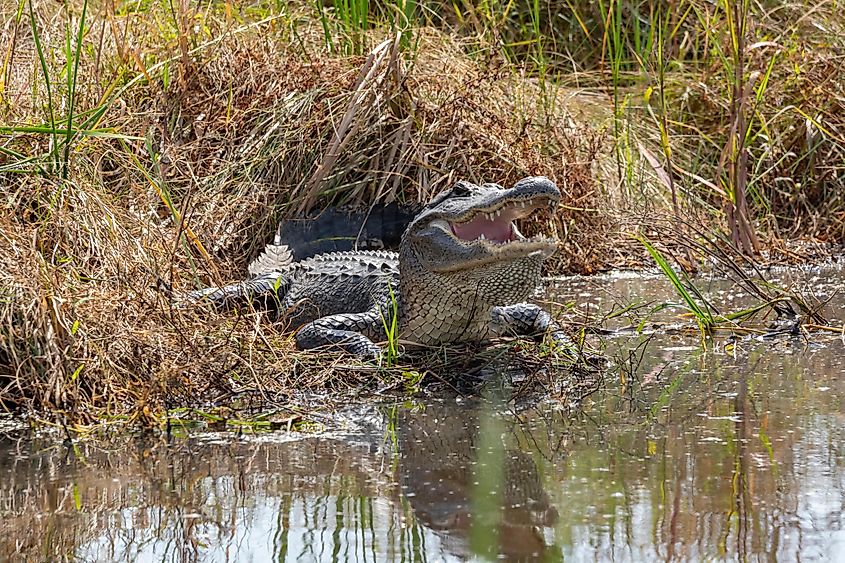
The American alligator (Alligator mississippiensis) is commonly associated with Florida, but it can also be found throughout the Eastern third of Texas – near freshwater swamps, marshes, rivers, and bayous. Brackish water is also tolerable. This massive, armored, dark-colored (almost black), and vocal reptile can reach 6 to 14 feet in length (not including the tail). It also has a long head, with protruding eyes, and visible upper teeth. This semi-aquatic creature likes to submerge most of its body (save for eyes and nostrils) and wait to snatch any number of critters that constitute its menu (i.e., fish, lizards, turtles, smaller mammals, water birds, crustaceans, and even other alligators). At the same time, this alligator is surprisingly speedy on land (over short distances, at least). The American alligator is considered a protected game in Texas. It faced extinction only a short time ago but has rebounded sufficiently over the past 30 years to be officially delisted.
Black-Footed Ferret
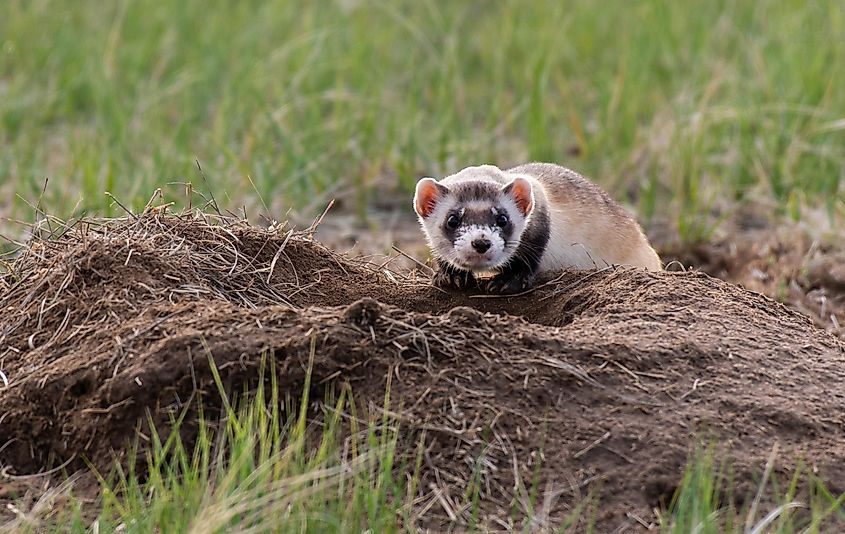
Another endangered species, both federally and locally, is the black-footed ferret (Mustela nigripes). These furry critters have light-brown, slender bodies, with, as the name suggests, black (or dark-brown) feet and legs, as well as a black-tipped tail. Its face is raccoon-like, with a white base and black mask. However, because they are nocturnal, black-footed ferrets are rarely seen. It is also worth noting that the black-footed ferret, though it historically occupied the totality of the Panhandle, has not actually been documented in Texas since 1963 (but hope remains!). Wild populations have retreated to Wyoming, South Dakota, and Montana. The unfortunate and complicated reasons for their demise in the Lone Star State are the loss of habitat (the shortgrass prairies that they rely on have long since been plowed for agriculture) and the commensurate demise of their primary food source: prairie dogs.
Ocelot
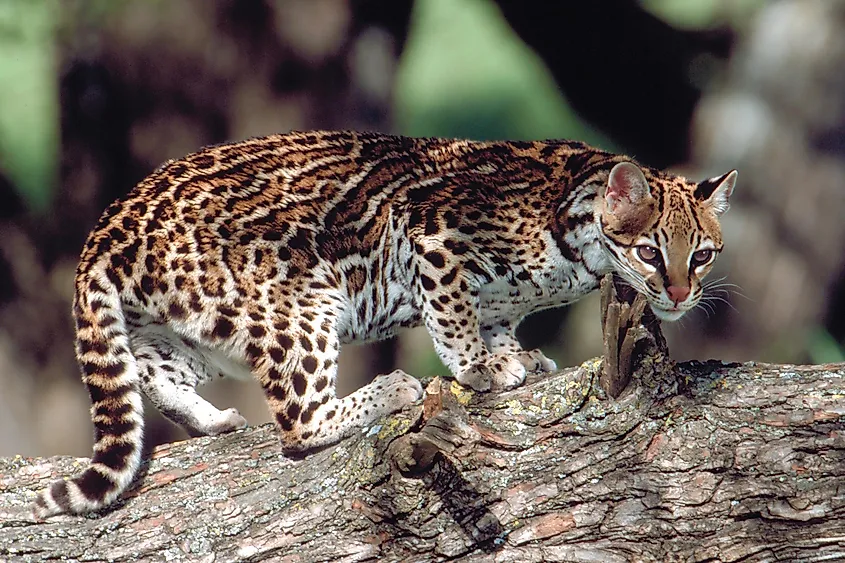
The last endangered animal on our list (both federally and in Texas) is the ocelot (Leopardus pardalis). This medium-sized cat is equal parts adorable and cool. It has cream-colored fur and lots of reddish-brown spots that are outlined in black. Ocelots can grow between 30 and 41 inches in length and weigh between 15 and 30 pounds. These nocturnal carnivores primarily hunt rabbits, rodents, and birds. During the day, they retreat to thick brush so as not to be disturbed. Tragically, such habitats have also been cleared for farming purposes and to allow for the expansion of cities. Now, only about 30 to 35 individuals remain in and around the Laguna Atascosa National Wildlife Refuge, just outside Brownsville, on the southern tip of Texas.
Mountain Lion
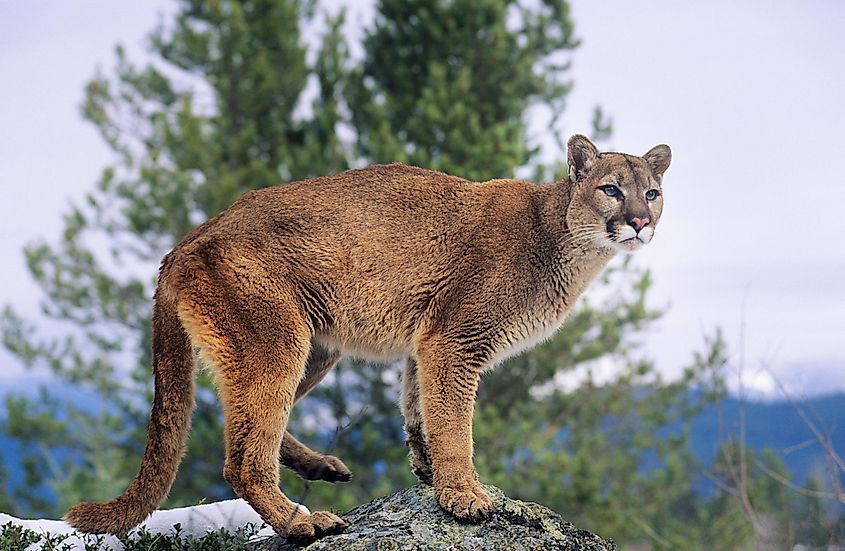
The mountain lion (Puma concolor), aka cougar, is another cat that roams throughout parts of Texas. It is quite a bit larger than the ocelot, with an average body length of 3 to 4 feet (plus a 2.5 to 3-foot tail), and weighs between 70 and 170 pounds, and thankfully, despite some challenges, has the widest distribution of any wild cat. The elusive mountain lion likes to stake out territory within remote mountains, canyonlands, and other undulating areas that have good cover – anywhere from Canada down to South America (though North American populations have predominantly been pushed into the West). In Texas, cougars reside throughout the Trans-Pecos region, portions of Hill Country, and the brushlands of the South.
Not everything is bigger in Texas. In fact, many of the coolest animals are small and rarely seen. The whooping crane, mountain lion, and Texas longhorn are obvious exceptions and tend to make perfect poster animals to represent the majesty of the Lone Star plains, high country, coast, desert, and plethora of other niches. But patience and a closer inspection reveal so many more captivating animals in these parts – and some of them need our help. Our rapid population growth has greatly reduced the capacity for other creatures to survive. The preservation of key environments and the protection status afforded to certain animals in recent decades has created a hopeful situation, but diligence is still required. A conservation mindset starts with a passion for nature, and there's no better way to stoke that flame than by studying the coolest animals around.











